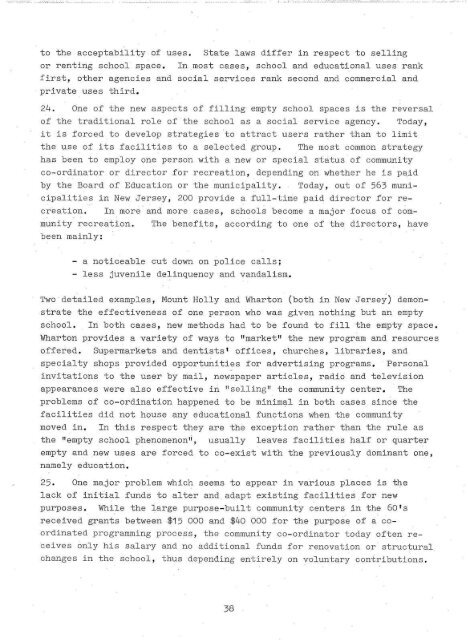BUILDING FOR SCHOOL AND COMMUNITY - Kennedy Bibliothek
BUILDING FOR SCHOOL AND COMMUNITY - Kennedy Bibliothek
BUILDING FOR SCHOOL AND COMMUNITY - Kennedy Bibliothek
You also want an ePaper? Increase the reach of your titles
YUMPU automatically turns print PDFs into web optimized ePapers that Google loves.
to the acceptability of uses. State laws differ in respect to selling<br />
or renting school space. In most cases, school and educational uses rank<br />
first, other agencies and social services rank second and commercial and<br />
private uses third.<br />
24. One of the new aspects of filling empty school spaces is the reversal<br />
of the traditional role of the school as a social service agency. Today,<br />
it is forced to develop strategies to attract users rather than to limit<br />
the use of its facilities to a selected group. The most common strategy<br />
has been to employ one person with a new or special status of community<br />
co-ordinator or director for recreation, depending on whether he is paid<br />
by the Board of Education or the municipality. Today, out of 563 municipalities<br />
in New Jersey, 200 provide a full-time paid director for recreation.<br />
In more and more cases, schools become a major focus of community<br />
recreation. The benefits, according to one of the directors, have<br />
been mainly:<br />
- a noticeable cut down on police calls;<br />
- less juvenile delinquency and vandalism.<br />
Two detailed examples, Mount Holly and Wharton (both in New Jersey) demonstrate<br />
the effectiveness of one person who was given nothing but an empty<br />
school. In both cases, new methods had to be found to fill the empty space.<br />
Wharton provides a variety of ways to "market" the new program and resources<br />
offered. Supermarkets and dentists' offices, churches, libraries, and<br />
specialty shops provided opportunities for advertising programs. Personal<br />
invitations to the user by mail, newspaper articles, radio and television<br />
appearances were also effective in "selling" the community center. The<br />
problems of co-ordination happened to be minimal in both cases since the<br />
facilities did not house any educational functions when the community<br />
moved in. In this respect they are the exception rather than the rule as<br />
the "empty school phenomenon", usually leaves facilities half or quarter<br />
empty and new uses are forced to co-exist with the previously dominant one,<br />
namely education.<br />
25. One major problem which seems to appear in various places is the<br />
lack of initial funds to alter and adapt existing facilities for new<br />
purposes. While the large purpose-built community centers in the 60's<br />
received grants between $15 000 and $40 000 for the purpose of a coordinated<br />
programming process, the community co-ordinator today often receives<br />
only his salary and no additional funds for renovation or structural<br />
changes in the school, thus depending entirely on voluntary contributions.<br />
38
















